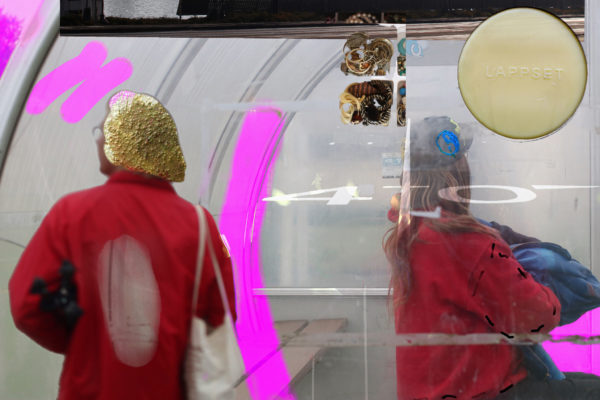Exercised Subordination: Desire and Art (World)
Sakari Tervo
I have this reoccurring desire to exercise more. It may be because of body image pressures, but it is also related to health concerns. As I am over 30 and my aging body has begun its eventual degrade, it seems sensible to slow down the process and not spend days in front of a good / bad screen. But when an urge to go running or swimming arises, I rarely go or follow it. It is usually the case of not having enough time, money, energy—or some combination of these. It seems impossible to find a moment where any of these three aren’t on their way. Typically, I undergo few days of anxiety before forgetting my unease, and then I float back onto the river Denial.
Desire was something that I thought about when I read Shirley Jackson’s “The Lottery” (1948). Jackson’s text reminds me of Ursula Le Guin’s short story “The Ones Who Walk Away From Omelas” (1973) in that both share the theme of scapegoating and exposing its signification to social structures. In Le Guin’s text, the narrator depicts a summer festival in the utopian city of Omelas, whose art and prosperity depend upon the misery of a single child kept inside a broom room in perpetual filth and darkness. The citizens of Omelas are aware of the child and most, initially shocked, ultimately accept this injustice to secure the happiness of the rest of the city. Desire, in both stories, functions as motivation for the community to accept injustice for their own benefit (e.g., wealth and joy). Desire should not be seen as something airy or fuzzy, but as something that manifests ideology and morality in human social interactions. Desire keeps communities together as it defines what needs to be excluded, for the sake of their desire (e.g., a plentiful harvest, wealth and joy). That is to say, desire enables the crime.
There are other similarities in these two texts by Jackson and Le Guin; both are set in an archetypal utopian setting, a stand-alone or remote village (city), and both focus on summer festivities (in Jackson’s case, the word ‘festivity’ includes the ritual of murder). However, Le Guin’s text feels more optimistic and a more fitting allegory for the art world with its act of exclusion (isolation of the child) when compared to quick expulsion (stoning to death).
What I find intriguing in Le Guin’s story is the two-way act of exclusion and inclusion—keeping something out but at the same time within (anthropologist Elizabeth A. Povinelli wrote about Le Guin’s story in her book Economies of Abandonment (2011), where she exposes this logic in relation to Aboriginal Australians and late liberalism). The child in the broom room is kept alive, and its existence is necessary for the community. The child is not something outside of it but strongly positioned at its center—that is to say, the disgusted yet desired member of the community. Everything revolves around the child, as the community needs the child’s existence for the sake of their wealth and prosperity (compared to Jackson’s story, where the annually selected sacrificial victim serves a more transitory role between farming cycles).
I find this two-way act of exclusion and inclusion to be fitting logic for the art world. To me, the art world appears as an immense flow of artists, curators, critics, ad infinitum who both desire and compete for similar or exact components (e.g., visibility, resources, authority). This rivalry of desires can be understood as a ‘game’ which revolves around who is able to be visible (included) and who is forced to disappear (excluded) from the art world’s transitory stages (visibility understood as self-explanatory, but also what it constitutes together with resources and authority). Inevitably, one needs to perform in this ‘game,’ albeit the rules, interactions and causalities can, at times, be hard to comprehend (at least this is how I feel). In this ‘game,’ exclusion functions as a way for the dominant instances to uphold a fixed language, content and structures of production and representation concerning art (needless to say, the dominant also uphold a set of limits based on class, gender and ethnicity within cultural, geographic and political contexts). At the same time, exclusion also reinforces and intensifies shared beliefs in the valuation of the dominant ideal of art (world), since the instances that have gained authority over the desirable (visibility, resources, authority) have made it even more scarce. In this logic, the two-way act of exclusion and inclusion occurs as there is still the need for the excluded to desire that which is denied from them. In a way, their (useless) desire is still something that validates dominance for others, as they continue to participate in maintaining the dominant ideal of art (world).
Desire is addressed in the cultural critic Rey Chow’s text “Sacrifice, Mimesis, and the Theorizing of Victimhood.” Here she speculates on the conceptual relation between mimesis and sacrifice, and how desire is interlinked between these two. Chow defines the relation between mimesis and sacrifice as “… a double epistemic passage underlying all acts of signification, a passage that tends to become acute in context of dominance and subordination, in which loss and gain are existentially palpable phenomena impinging on individual and group identity formation.” She then brings forth the idea of mimesis as a coping mechanism (Luce Irigaray’s concept of femininity as ‘masquerade,’ whereupon women must imitate or reproduce norms of femininity which have been prescribed in advance by patriarchal mores) and as a survival tactic (Homi Bhabha’s notion of black subjectivity and the need to imitate those who victimize: white subjectivity). She then writes about René Girard’s mimetic theory in relation to the above but also how mimesis, in Girard’s theory, acts as an original force in generating desire. For Girard, desire is something which can be learned, borrowed and transferred. Desire, that is to say, is an outcome of human social interaction, and mimesis is something that activates the act of desiring; it is what gives desire its direction and trajectory as well as its objects. This mimetic nature of desire also generates competition that can accelerate into reciprocal violence. To restrain the rivalry, there is a need for what Girard calls the scapegoat mechanism. Therefore, the scapegoat is a structural and social necessity for a community to stop the endless circle of violence through an act of exclusion. Usually, the randomly chosen victim is sacrificed not because of his qualities (e.g., weak, strong), but because he resembles the community and its endless ability to retaliate: because he is just like us.
So, if the art world can be seen as an immense flow of shared desires in constant competition, and scapegoating is a structural part of this mimetic desiring, as Girard argued, then how should one imagine the art world without its sacrificial victims? Or: if scapegoating is structurally part of the art world, could there still be a way to use the mimetic nature of desire against potentially corrupt structures within it? In other words, to use it against itself?
A hint of optimism is revealed in the ending of Le Guin’s story when the narrator tells of citizens leaving Omelas: “The place they go towards is a place even less imaginable to most of us than the city of happiness. I cannot describe it at all. It is possible it does not exist. But they seem to know where they are going, the ones who walk away from Omelas.” For me, this ending signifies the capacity to start desiring something else. The ‘wealth and joy’ of Omelas may become undesirable, and if so, then the unjust action (the child in the broom room) would lose its significance. Here lies the possibility to break a corrupt social structure by refusing to participate in maintaining it (for me, walking away is a metaphorical act … not actual). That is to say, to realize that the city of Omelas is a place where people are captivated (not the broom room), and this understanding is something to which those who “walk away” are reacting to by leaving. Le Guin’s ending has a redundant individualistic aura (the narrator repeats “each one goes alone”), but this reading possesses a different tone when observed through Girard’s mimetic theory. If desire is always learned, borrowed and transferred in human social interaction, it makes desiring a collective affair with collective accountability. Then those who “walk away” cannot do it solely from their own thoughts—but only in relation to others. They need others to start desiring in the first place, and for me, a collective desire is a more powerful implement than an individualized one. Yet again, desire in this case, is the shared understanding of an alternative, but it was also that which kept citizens attached to Omelas. The mimetic nature of desire is therefore the problem and solution: the snake’s blood and its venom.
Girard’s mimetic theory is a useful tool for examining the art world’s structures and its ‘game’: we desire certain kinds of ideals about art (world)—because others desire them too (mimesis being the original force generating desire). And as the valuation of art is based on mimetic desire (rather than in anything actual), the value (desire) is something which is always negotiated in the competition (‘game’) between those who participate in it. It is important to pay attention to who is and is not able to take part in this competition—for their own reasons (refusal) or because they are not allowed take part—since the ‘game’ is where the most visible desire originates. Exclusion and inclusion are the actions which create domination, as it functions as a legitimization passage between desire and the undesirable, reinforcing and intensifying shared belief in the valuation of the dominant ideal of art (world). That is to say: “to make art (world) like us, not like them” (and this implies everything that constitutes ‘us’ … from class, gender, ethnicity onward). But as I pointed out earlier, there is still the two-way need for the excluded to desire what is denied from them. To believe that the dominant ideal of art (world) is a thing towards they need to strive on, even it might actually be the thing that subordinates them. This kind of dynamic is addressed in Lauren Berlant’s book Cruel Optimism (2011); she writes about ‘cruel optimism’ where something that you desire is actually an obstacle to your flourishing. In her book, she addresses the fantasies of the good life that the welfare state model promised but what late liberal-capitalist societies can no longer provide for: that your life and work “add up to something.” In this way, desire can also be a mental state where the unfulfilled but ever-looming promise can imprison the desirer into an endless (useless) longing for fulfillment—rather than questioning desire itself.
So, the question is how to break away from an oppressive relationship with one’s desires—if abuse is simultaneously denied but sustained (and by desire, I refer to it as something that manifests ideology and morality, as well as that which intensifies a belief in the valuation of a certain language, content, structures of production and representation concerning art [world]). How does one begin questioning one’s desires, so as to ‘unlearn’ or ‘relearn’ them? And what are the individual’s possibilities (and responsibilities), since desire only takes shape in relation to others (as there is no desire without the other)?
‘Cruel optimism’ is something that may be unfolding in my reoccurring, but unfulfilled, desire to exercise more. Albeit I am motivated by health concerns (and body image pressures), the reasons (lack of time, money, energy) are what constantly prevent me from carrying out my desire. That is to say, these things (or the absence of them) have a more dominating role in my everyday life rather than the ambivalence of future health problems (or death). Here I would like to emphasize that I am not speaking up for a ‘World of Fitness’; I am speaking on a personal level about my relationship to my body—body as the ultimate basis for valuation (since I have only one). If I cut corners, I can admittedly blame the constant lack of time, money and energy on my involvement with the art world and its precarious conditions. Thus, I feel something akin to ‘cruel optimism’ as I am still motivated to be with and around art—even after several years with little (or no) income; being stressed, ill, uncertain, embarrassed; working constantly (on multiple things), with no clear future plan on how to improve conditions, let alone keep myself healthy or fit. Occasionally, I do feel that “it doesn’t add up” and that I am left without (or excluded). Hence, if ‘cruel optimism’ is something that stays simultaneously denied but sustained, I am not always sure which side I am on.
As I write this text from inside this complexity (rather than outside of it), I cannot give solutions to these questions that I have addressed. It feels easier to write metaphorically through Le Guin’s text, rather than to pinpoint this to a set of clear thoughts. But what I am thinking, or trying to find out, is a way to make the excluded (the child in the broom room) stronger and more competent than at first it seems. To realize that it is the ideals of the dominants (citizens of Omelas) who create the assumption that the broom room is a shit hole—but that this understanding may be false. That it is just a way to downplay alternatives, to create illusions (or warnings) that there are right and wrong ways to exist. And by taking over the authority to exclude and include, the citizens of Omelas are just reinforcing their own ideals of life (or desires)—not necessarily others. One’s reaction to this two-way act of exclusion and inclusion is crucial, as it can sustain the authority by keeping one out of reach … but on a leash. But it can also be a way to question the dominants—by not submitting to their ideals of what is accepted or not (to question exclusion altogether). The mimetic nature of desire is then at a crossroads; it has the capacity to sustain or shatter dominance.
On a day like any other, a gentle wind would carry a melody far off from the North where the mountains stood up. This melody, that must have been written hundreds of years ago, wasn’t well-known for the joyous citizens Omelas, they didn’t know whom, or what, was making the melody, since there was nobody living outside of the beautiful city gates. At first, they could only recognize the lighthearted melody, but as the gentle wind gradually built up, they could start recognizing those playful lyrics louder, and louder:
You said our love was sacred
But you left me alone to make it
You want to come back again someday
But darling here’s what I say
Ladidadida
Ladidadida
Ladidadida
Ladidadida
All rights reserved.





























